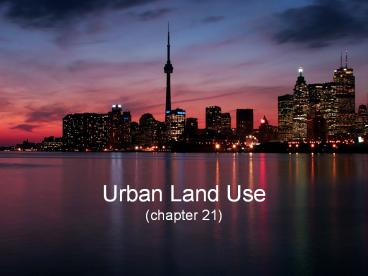Urban Land Use (chapter 21) - PowerPoint PPT Presentation
1 / 10
Title:
Urban Land Use (chapter 21)
Description:
Urban Land Use (chapter 21) Six Major Land-Use Groups Residential - where people live from single-family houses to huge apartment buildings. – PowerPoint PPT presentation
Number of Views:150
Avg rating:3.0/5.0
Title: Urban Land Use (chapter 21)
1
Urban Land Use(chapter 21)
2
Six Major Land-Use Groups
- Residential - where people live from
single-family houses to huge apartment buildings.
Usually the largest land use in cities (40) - Residential density of houses per hectare
affected by cost of land and age of neighbourhood
(trend has gone from dense to less dense back to
dense) - See page 249
3
- 2. Transportation 1/3 (33) of developed land
in most cities is used for roads and highways. - Vehicles can create a large amount of
congestion. Mass-transit systems help this
subway, rail line, bus lane. Expensive, but
worth it in highly dense areas. - Terminal Facilities at the end of all travel
paths train, bus stations, airports, docks,
parking lots
4
- Travel Paths subway, street car,
- and roads and highways 4 types
- Expressways largest- capacity, carry huge
amounts of traffic quickly over long distances - Arterial roads moderate amounts of traffic,
shorter distance - Collector roads move traffic from local roads
to arterial roads - Local roads small and narrow, take people from
home to arterial or collector roads
5
- 3. Commercial Land Use
- - about 5 of citys land use
- - Buying and selling of goods and services
(business) important for the economy - 6 main types
- Local service centres (Macs Milk)
- Neighbourhood Plazas and Ribbons (supermarket)
- Community Shopping Centres (Malls)
- Power Centres (big-box stores Canadian Tire)
- Regional Shopping Centres (big malls, department
stores) - The Central Business District (CBD) (down-town
financial, retail, entertainment, hotel)
6
- Industrial Land Use(6)
- - Factories (processing and manufacturing)
- - Warehousing (storage)
- - shipping products
- Types
- - CBD industries,
- - ribbon industries,
- - suburban industrial parks
- - suburban business parks
- See page 256
7
- Institutional and Public Buildings
- (10) schools, hospitals, government offices,
places of worship - Open Space and Recreational Land
- (7) open land vacant, wood lot, cemetery
- recreational parks golf course, arenas
8
Factors Affecting Land -Use Patterns
- Land- use patterns in towns and cities do not
develop by chance. They result from decisions
made by people about such matters as where to
work, what type of home to live in, what kind of
local government to have, and how to spend money.
Your decisions will affect the way your
community looks in the future. - - text page 264
9
- 1. Land value
- Land values are generally the highest in the most
accessible areas (ex. CBD) and along major
transportation routes - Zoning
- Lows that control the kind and amount of
development in an area - Climate
- Winter-city concept participate in city life
all year long (you dont even have to step
outside)
10
- Urban Expansion
- - Rural-urban fringe area next to a an urban
are where there is a mixture of urban and rural
land uses city expands outwards ( loss of
productive farm land) - - Urban Sprawl low-density development
surrounding a city - Read pages 261-263































